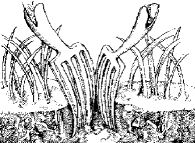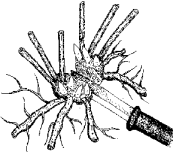 |
How to Divide |
||||||||||||||
Get Our Free Newsletter
|
Division is most successful when the parent plant is dug, divided and all plants immediately replanted. If you must hold the newly divided plants for a short period of time, keep them cool, shaded and moist. Wet some peat moss or shredded newspaper and cover the plants with several inches of the material. This method of propagation is simple and requires only a few tools, a small amount of planning and plenty of elbow grease and back strength. Before dividing a plant, prepare the area where the new divisions will
be located. This allows you to quickly put the plants back into the
ground and increases survival rates. Next gather the tools you’ll
need; most divisions can be done using a spade and either two garden
forks, a large butcher knife or a folding pruning saw. The type of
plant you’re dividing will dictate what type of a cutting device will
be needed. Use the spade and cut around the outer perimeter of the
plant. Loosen the plant with a garden fork, lift the clump out of the
ground and remove most of the soil from the roots. Soil is removed
from the roots so the individual plants within the clump become
visible. Observe the plant crown and discard any portion that is
severely injured or appears unhealthy.
A daylily is easily divided by placing two garden forks back-to-back in the center of the clump. Pulling the handles together and then pushing them apart causes the fork tines to separate the roots. Once the clump has been loosened, new divisions that contain two to three shoots can be separated out. Iris need to be divided about every 3 years because the center of the plant dies due to crowding. Divide by separating the vigorous rhizome side shoots from the old mature rhizome. How quickly a newly planted division blooms is largely dependent on the size of the division. If you want blooming to occur next spring, divide the clump into a few large plants. If you want large numbers of a plant and are willing to wait several years for blooms, divide the clump into many small plants. Regardless of size, all divisions should be planted immediately so they can become established before cold weather arrives. Providing winter protection may help poorly established plants survive cold weather. Thoroughly water any plants that are to be divided the day before division begins. This water will help loosen the soil and hydrate the root system. Try to do the division on a cloudy or overcast day and have a bucket of water at the site. After dividing, soak the root system in the bucket of water for about an hour prior to planting in the new location. Water thoroughly immediately after planting and closely monitor the soil moisture for several weeks after planting. Provide temporary shade to help the divisions establish quickly. Originally published by the University of Missouri |
||||||||||||||
|
|
|||||||||||||||
|
© 1999 - 2010 Savvygardener.com, Inc. All rights reserved. If you wish to copy, transmit, or otherwise duplicate any of the material from our website please ask us first. Thank you. |
|||||||||||||||

 Throw away the old mature portion. Trim the foliage back by
50% before replanting the new divisions. Peonies can be divided by
cutting the tuberous roots into pieces that contain three to five eyes
or buds. Poppies can be divided by cutting the roots into 4-inch
sections.
Throw away the old mature portion. Trim the foliage back by
50% before replanting the new divisions. Peonies can be divided by
cutting the tuberous roots into pieces that contain three to five eyes
or buds. Poppies can be divided by cutting the roots into 4-inch
sections.